
William Blake's illustrations of On the Morning of Christ's Nativity
Encyclopedia
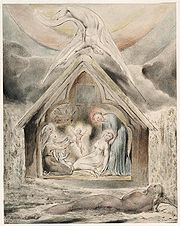
William Blake
William Blake was an English poet, painter, and printmaker. Largely unrecognised during his lifetime, Blake is now considered a seminal figure in the history of both the poetry and visual arts of the Romantic Age...
drew and painted illustrations for John Milton
John Milton
John Milton was an English poet, polemicist, a scholarly man of letters, and a civil servant for the Commonwealth of England under Oliver Cromwell...
's nativity ode On the Morning of Christ's Nativity
On the Morning of Christ's Nativity
On the Morning of Christ's Nativity is a nativity ode written by John Milton in 1629 and published in his Poems of Mr. John Milton . The poem describes Christ's Incarnation and his overthrow of earthly and pagan powers...
between 1803 and 1815. A total of 16 illustrations are extant: two sets of six watercolours each, and an additional four drawings in pencil.
The dating of the sets is unknown, as is Blake's intended sequence for the illustrations. The two sets of watercolours are known as the "Butts set" and the "Thomas set", after their respective patrons, or as the "Huntington set" and the "Whitworth set" after the Huntington Library and the Whitworth Art Gallery
Whitworth Art Gallery
The Whitworth Art Gallery is an art gallery in Manchester, England, containing about 55,000 items in its collection. The museum is located south of the Manchester University campus, in Whitworth Park....
, which now hold the sets in their collections.
Provenance
There is little record of the provenanceProvenance
Provenance, from the French provenir, "to come from", refers to the chronology of the ownership or location of an historical object. The term was originally mostly used for works of art, but is now used in similar senses in a wide range of fields, including science and computing...
of the Thomas set or the Butts set before 1852 and 1872, which has led to disputes about the dating. What is known is that the "Thomas set" was commissioned by the Reverend Joseph Thomas, who had also commissioned illustrations to Milton's Comus and Paradise Lost
Paradise Lost
Paradise Lost is an epic poem in blank verse by the 17th-century English poet John Milton. It was originally published in 1667 in ten books, with a total of over ten thousand individual lines of verse...
from Blake. No contract for the commission is extant, but the commissioning probably took place in 1809, which is the year in which the illustrations were completed. Blake was eager to accept the commission, according to G. E. Bentley, because "Milton illustrations were a kind of work which Blake could not resist." They presumably stayed in the Revd Thomas's family until they were bought at Sotheby's
Sotheby's
Sotheby's is the world's fourth oldest auction house in continuous operation.-History:The oldest auction house in operation is the Stockholms Auktionsverk founded in 1674, the second oldest is Göteborgs Auktionsverk founded in 1681 and third oldest being founded in 1731, all Swedish...
from an anonymous seller in 1872. By 1876 they were in the collection of J.E. Taylor, who gave them to the Whitworth in 1892.
Even less is known about the dates of composition for the "Butts set" - between 1811 and 1820, Blake created at least thirty three designs for Thomas Butts, which included the illustrations of "On the Morning of Christ's Nativity". Later, they passed from Butts to his son, who sold them at Sotheby's in 1852, passed through several more hands, were sold at Christie's
Christie's
Christie's is an art business and a fine arts auction house.- History :The official company literature states that founder James Christie conducted the first sale in London, England, on 5 December 1766, and the earliest auction catalogue the company retains is from December 1766...
in 1912, and in 1916 were sold to Henry Huntington.
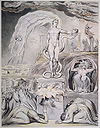
Dating and sequence
The illustrations themselves do not make the dating any easier- the edges of the "Thomas set" were trimmed before sale at Sotheby's, leaving "18" or "180" on most of the sheets. Only The Night of Peace bears the full date of 1809. The Butts set is entirely undated- dates from 1803 to 1817 have been proposed for it. Behrendt argues that the Butts set predates the Thomas set by six years, and Collins Baker and R.R. Wark place it in 1809, but earlier than the Thomas set.The sequence of the illustrations is also a topic of scholarly dispute: the mountings of the Thomas set were inscribed on their backs with numbers 1-6, but these were added during or after the 1872 Sotheby's sale, and so are unlikely to follow Blake's intended order. This "original" order ran thus:
- The Descent of Peace
- The Annunciation to the Shepherds
- The Flight of Moloch
- The Old Dragon
- The Overthrow of Apollo and the Pagan Gods
- The Night of Peace
Geoffrey Keynes
Geoffrey Keynes
Sir Geoffrey Langdon Keynes was an English biographer, surgeon, physician, scholar and bibliophile...
placed them in 1-6-2-3-4-5 order, so that The Night of Peace followed The Descent of Peace, because of their similar subjects. Butlin, and nearly all subsequent scholars, have rejected this, as much commentary has centered upon Blake's use of similar images to frame the sequence. Butlin instead rearranges the "original" sequence as 1-2-4-5-3-6, moving The Flight of Moloch to second to last, so that it matches the order of corresponding verses in Milton's poem. Dunbar also follows Butlin's order. Behrendt adopts a 1-2-5-3-4-6 order, seeing a thematic progression from the destruction of classical aesthetics, to the old testament cruelty of Moloch (who resembles Blake's Urizen
Urizen
In the complex mythology of William Blake, Urizen is the embodiment of conventional reason and law. He is usually depicted as a bearded old man; he sometimes bears architect's tools, to create and constrain the universe; or nets, with which he ensnares people in webs of law and conventional culture...
), to Satan
Satan
Satan , "the opposer", is the title of various entities, both human and divine, who challenge the faith of humans in the Hebrew Bible...
himself. This order is followed by Werner in her Blake's Vision of the Poetry of Milton.
Analysis
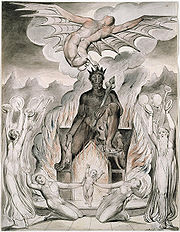
Milton: a Poem
Milton a Poem is an epic poem by William Blake, written and illustrated between 1804 and 1810. Its hero is John Milton, who returns from Heaven and unites with Blake to explore the relationship between living writers and their predecessors, and to undergo a mystical journey to correct his own...
is a guide to Blake's idea of Milton: that he possessed true spiritual vision, but fell by his adherence to the moralistic and repressive tenets of puritanism
Puritan
The Puritans were a significant grouping of English Protestants in the 16th and 17th centuries. Puritanism in this sense was founded by some Marian exiles from the clergy shortly after the accession of Elizabeth I of England in 1558, as an activist movement within the Church of England...
and by his preference for the cruel and distant Jehovah
Jehovah
Jehovah is an anglicized representation of Hebrew , a vocalization of the Tetragrammaton , the proper name of the God of Israel in the Hebrew Bible....
of the Old testament
Old Testament
The Old Testament, of which Christians hold different views, is a Christian term for the religious writings of ancient Israel held sacred and inspired by Christians which overlaps with the 24-book canon of the Masoretic Text of Judaism...
over the redemptive figure of Christ
Christ
Christ is the English term for the Greek meaning "the anointed one". It is a translation of the Hebrew , usually transliterated into English as Messiah or Mashiach...
. In that regard the Nativity Ode is to Blake the rebirth of Milton's poetry into the creative imagination of Christ. Blake also sees a return to prophetic, Christian ideals of poetry, rather than the "pagan" classical aesthetic
Classicism
Classicism, in the arts, refers generally to a high regard for classical antiquity, as setting standards for taste which the classicists seek to emulate. The art of classicism typically seeks to be formal and restrained: of the Discobolus Sir Kenneth Clark observed, "if we object to his restraint...
represented in The Overthrow of Apollo and the Pagan Gods by the figure of Apollo
Apollo
Apollo is one of the most important and complex of the Olympian deities in Greek and Roman mythology...
, who is modeled on the Apollo Belvedere
Apollo Belvedere
The Apollo Belvedere or Apollo of the Belvedere—also called the Pythian Apollo— is a celebrated marble sculpture from Classical Antiquity. It was rediscovered in central Italy in the late 15th century, during the Renaissance...
.
Blake's prophetic book
William Blake's prophetic books
The prophetic books of the English poet and artist William Blake are a series of difficult and obscure poetic works. While Blake worked as a commercial illustrator, these books were ones that he produced, with his own engravings, as an extended and largely private project...
Europe: a Prophecy was especially influenced by On the Morning of Christ's Nativity. In that poem, the messianic Orc
Orc (Blake)
Orc is a proper name for one of the characters in the complex mythology of William Blake. Unlike the medieval sea beast, or Tolkien's humanoid monster, his Orc is a positive figure, the embodiment of creative passion and energy, and stands opposed to Urizen, the embodiment of tradition.In Blake's...
, a symbol of pure creative energy, rises against the repressive institutions of Church and state. Orc is part of a doomed cycle- his rebellion is inevitably countered by the increased institutional repression of Urizen
Urizen
In the complex mythology of William Blake, Urizen is the embodiment of conventional reason and law. He is usually depicted as a bearded old man; he sometimes bears architect's tools, to create and constrain the universe; or nets, with which he ensnares people in webs of law and conventional culture...
. Europe in that light is seen as a pessimistic parody of Milton's poem. Orc is often associated with fire, and the closest parallel with him is found in The Flight of Moloch, where a child is about to be given to the god of sacrifice
Moloch
Moloch — also rendered as Molech, Molekh, Molok, Molek, Molock, or Moloc — is the name of an ancient Semitic god...
. The similarity of the orifice that frames the child to the shape of the stable in the other illustrations underscores the purpose of Christ's birth, and foreshadows the harrowing of hell
Harrowing of Hell
The Harrowing of Hell is a doctrine in Christian theology referenced in the Apostles' Creed and the Athanasian Creed that states that Jesus Christ "descended into Hell"...
.
The illustrations emphasize the simultaneous occurrence of the events they depict by the presence of the stable in almost every image, and by framing the set with two very similar images that focus on the peaceful victory of Christ over darkness. The Descent of Peace also has neo-platonic implications- it represents the descent of the soul into the body, which is symbolized by the cramped stable.
Table of Illustrations
The order followed here is that given by Butlin.| Thomas set | Butts set | Title | Corresponding Stanzas with excerpt | Related works by Blake |
|---|---|---|---|---|
 |
 |
The Descent of Peace | Hymn, Stanzas 1-3 "It was the winter wild, While the Heav'n-born child, All meanly wrapt in the rude manger lies..." |
 |
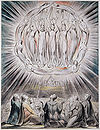 |
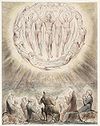 |
The Annunciation to the Shepherds | Hymn, Stanzas 8-12 "At last surrounds their sight A globe of circular light, That with long beams the shame-fac'd Night array'd..." |
|
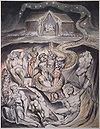 |
 |
The Old Dragon | Hymn, Stanza 18 "Th'old Dragon under ground, In straiter limits bound, Not half so far casts his usurped sway..." |
 |
 |
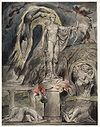 |
The Overthrow of Apollo and the Pagan Gods | Hymn, Stanzas 19-23 "Apollo from his shrine Can no more divine, With hollow shriek the steep of Delphos leaving..." |
|
 |
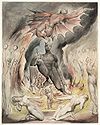 |
The Flight of Moloch | Hymn, Stanza 23 "In vain with cymbals' ring They call the grisly king, In dismal dance about the furnace blue..." |
 |
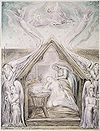 |
 |
The Night of Peace | Hymn, Stanza 27 "Heav'n's youngest-teemed star, Hath fix'd her polish'd car, Her sleeping Lord with handmaid lamp attending..." |

